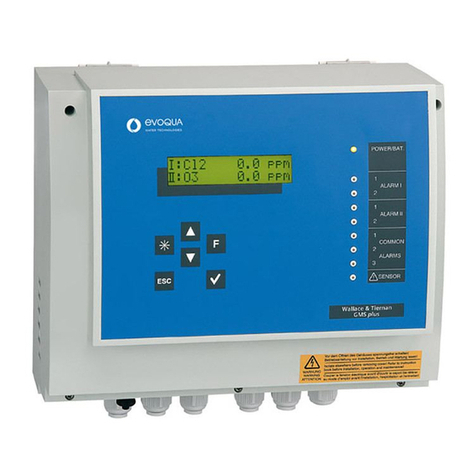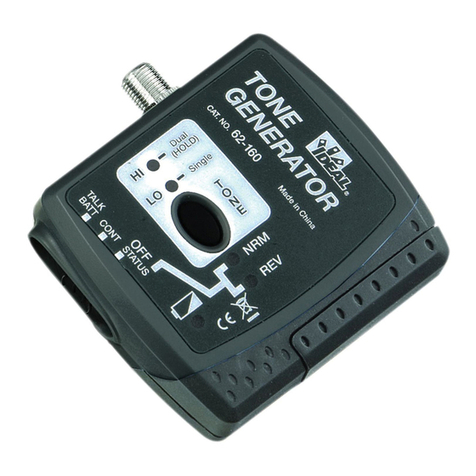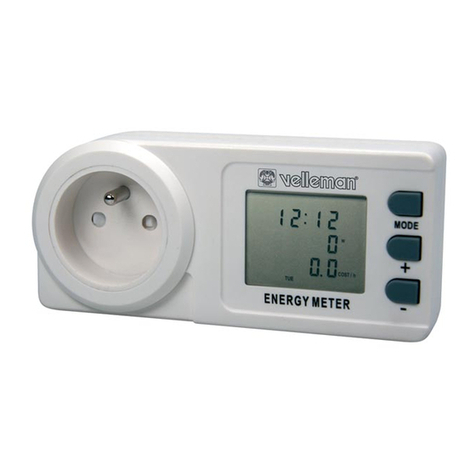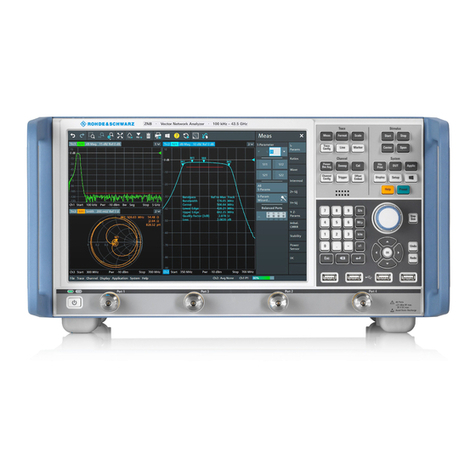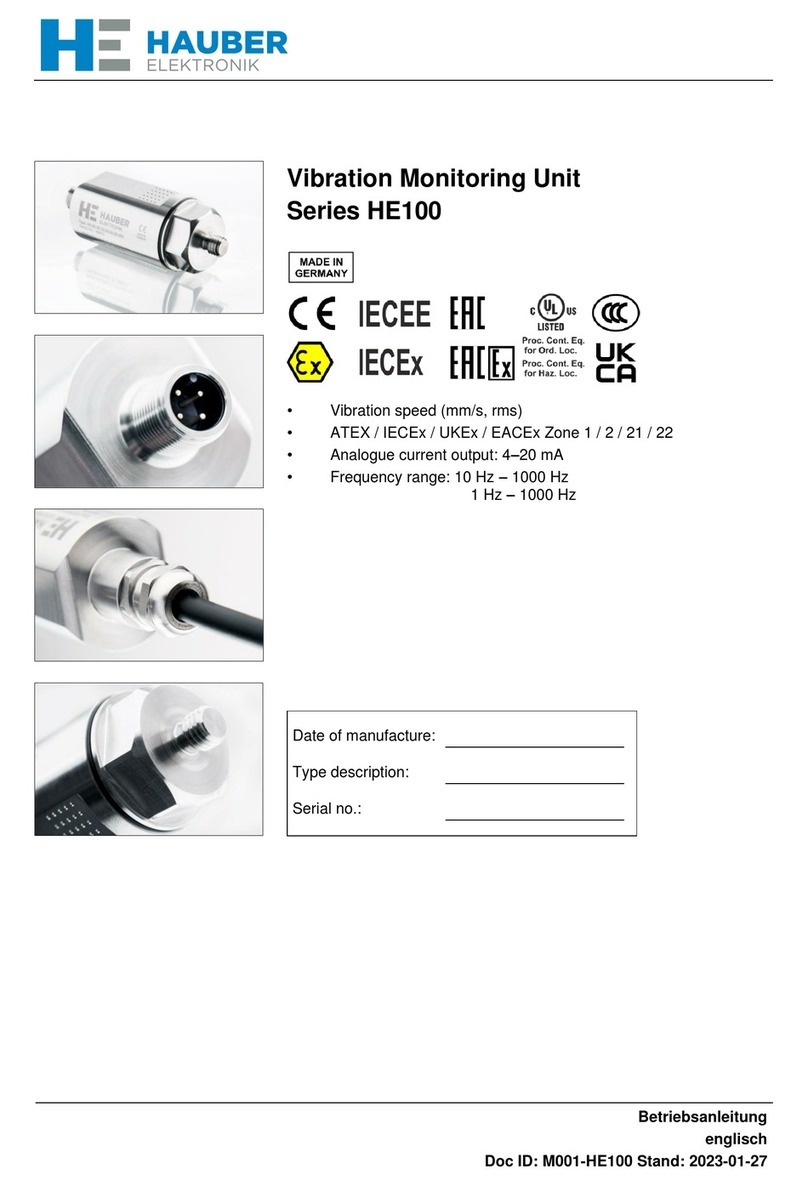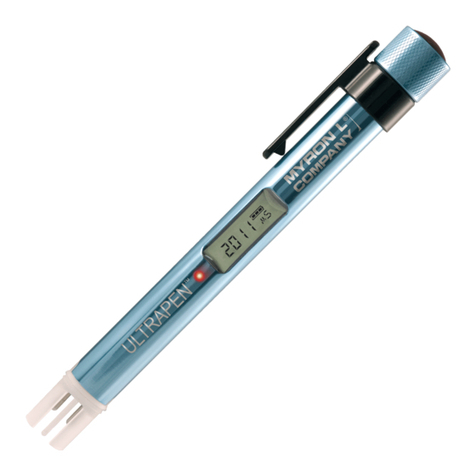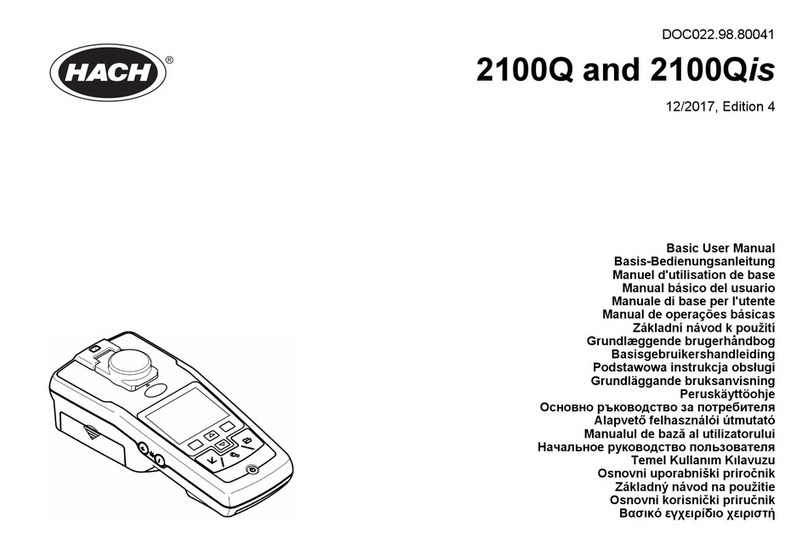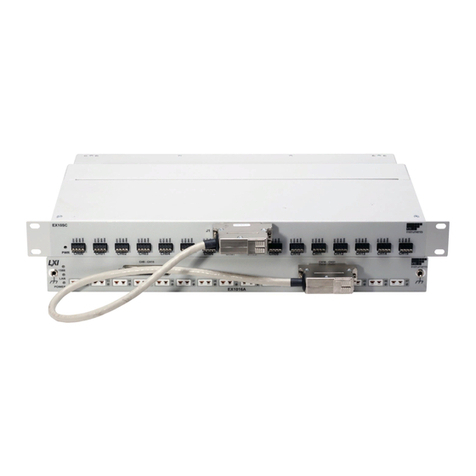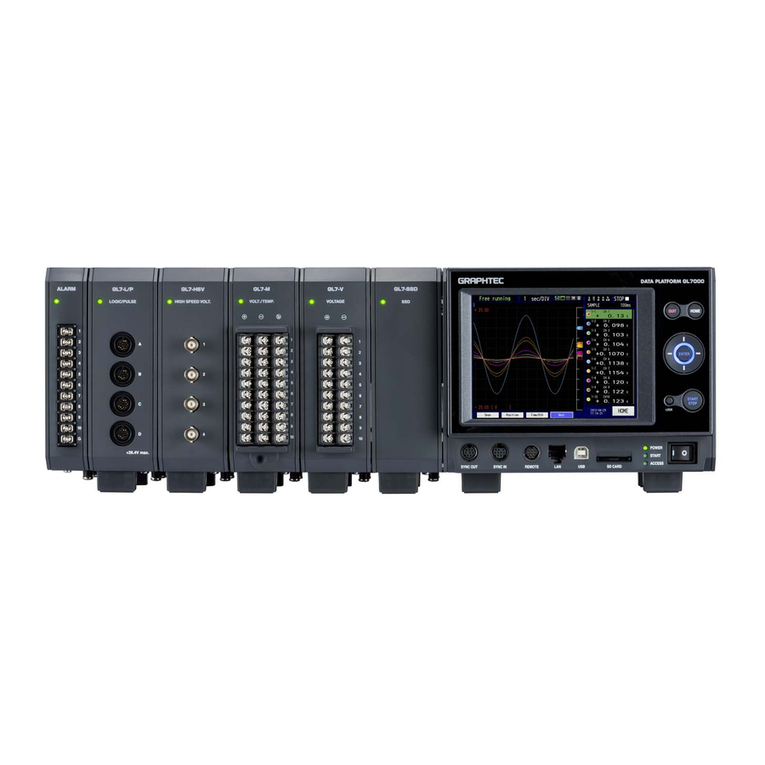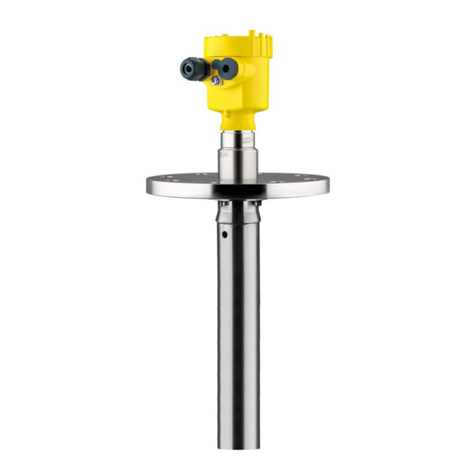Evoqua WALLACE & TIERNAN MICRO/2000 User manual

1
INSTRUCTION MANUAL
MICRO/2000
®
AND DEOX/2000
®
WALLACE & TIERNAN
®
MEASUREMENT
MODULE

MICRO/2000® AND DEOX/2000® MODULE
2
EN
In some countries, DEPOLOX, OSEC, Barrier, Chem-Ad and Wallace & Tiernan are trademarks of Evoqua, its subsidiaries or
affiliated companies. No part of this document may be reproduced in any form (printed, photocopy, microfilm, or any other
procedure) or saved, processed, copied, or distributed using electronic data systems - without the express prior written con-
sent of Evoqua Water Technologies GmbH.
All information in this document is considered reliable and corresponds to the generally applicable technical standards. Evo-
qua assumes no responsibility for the completeness of this information. Users are responsible for making sure that the pro-
duct is suitable for specific applications. Evoqua assumes no liability for specific or indirect damage or consequential
damage arising from the sale, resale or misuse of its products.
NOTICE
Original instruction manual!

MICRO/2000® AND DEOX/2000® MODULE
3
EN
Important Notice
Evoqua Water Technologies Instruction Manu-
als are the safety documents for their pro-
ducts. The information provided therein is in
accordance with the best practices known at
the time of issue and, if fully implemented,
should enable the user to operate the plant in
the safest possible manner. It is therefore
most important that instructions be read and
understood prior to the installation, operation
or maintenance of the plant.
Notes
Where necessary, special instructions are pro-
vided and are quoted under the following hea-
dings:
The following recommendations are made to
ensure safe and efficient operation:
1 Only suitably qualified personnel should
install, operate and maintain the equip-
ment.
2 Only Evoqua Water Technologies manu-
factured or approved parts should be
used.
3 The equipment should not be used for
any purpose other than that for which it
was supplied.
4 If equipment being supplied is being put
into storage or not being commissioned
immediately, or if the plant is being de-
commissioned, Evoqua Water Technolo-
gies urge that they be contacted for detai-
led advice.
In an effort to make progressive improve-
ments to products, changes in design may be
incorporated from time to time, which may
not be reflected immediately in the instruction
manual. If in doubt, contact Evoqua Water
Technologies quoting the equipment serial
number; serial numbers are essential for
effective communication and proper equip-
ment identification.
The equipment described in this manual may
be used with substances that themselves may
be hazardous to personnel safety. It is essen-
tial that persons employed in the vacinity of
such substances be aware of the appropriate
safety practices and the location of suitable
safety equipment. Provision of safety cards
and codes of practice concerning hazardous
substance should be made by the supplier of
the substance.
WARNING
A warning is given in instances where failure
to observe the instruction could result in
injury to personnel.
CAUTION
Cautions are given where failure to observe
the instruction may result in equipment
damage, or pollution to an allied system.
NOTICE
Notes are provided to give additional emp-
hasis to particular points of detail.

MICRO/2000® AND DEOX/2000® MODULE
4
EN
Warranty
The equipment supplied is guaranteed against
mechanical defect notified to the Seller within
a period of 1 year from the date of delivery.
For such guarantee to be valid the purchaser
must notify the seller in writing immediately
such defect becomes apparent. If the Seller so
requires, the Purchaser shall return the defec-
tive equipment (at the Purchaser's expense) to
the Seller. The Seller undertakes that it will, at
its own option and its own expense, and by
way of full discharge of its guarantee obliga-
tion hereunder, either repair, or supply a
replacement for the defective equipment, or
refund any purchase monies paid to it in
respect of any such defective equipment, or
portion thereof. If title to the defective equip-
ment is at the time of such replacement or
refund vested in the Purchaser, then title shall
thereupon vest in the Seller. Replacement
material situated outside the U.K. will be sup-
plied F.O.B. U.K. Port. The guarantee given in
this clause shall not be operative and enfor-
ceable if the equipment is not operated strictly
in accordance with the sellers instruction, or in
the respect of any defect arising from acci-
dent, deliberate act, misuse, neglect or from a
breach from the terms of the following clause,
or in respect of any defect arising through
damage incurred while being transported
after delivery of the equipment, or if the
equipment has been altered or modified in
any way by any person other than the seller, or
in respect of any other cause whatsoever
which lies beyond the Sellers control.
The Purchaser must comply with all user inst-
ructions and safety recommendations issued
by the Seller, and must install, commission and
maintain the equipment in accordance with
good engineering practice, and under the
supervision of suitably qualified personnel,
and the Seller shall not be liable to the Purcha-
ser for any loss suffered as a result of the Pur-
chaser's breach of the terms of this clause.
Subject to this guarantee all conditions, war-
ranties and representations, whether expres-
sed or implied (by statute or otherwise)
relating to the equipment, are hereby exclu-
ded in so far as they can be excluded without
such exclusion being void or unenforceable at
law.
Wallace & Tiernan, Barrier, Chem-Ad,
DEPOLOX, OSEC, and V10k are trademarks of
Evoqua, its subsidiaries or affiliates.
The designations used in this publication may
be trademarks whose use by third parties for
their own purposes could violate the rights of
the owners. All rights, especially those to
duplication and distribution as well as transla-
tion, are reserved. No part of this document
may be reproduced in any form (printing, pho-
tocopying, microfilm or any other method) or
saved, processed, duplicated or distributed by
the use of electronic systems without the
express written consent of Evoqua Water
Technologies.

MICRO/2000® AND DEOX/2000® MODULE Contents
5
EN
Contents
1 Introduction ............................................................................... 8
1.1 Target groups ..........................................................................................................8
1.2 Structure of the documentation .............................................................................8
1.3 Conventions.............................................................................................................8
2 Safety......................................................................................... 9
2.1 Intended Use ...........................................................................................................9
2.2 General Safety Instructions .....................................................................................9
2.3 Warranty Conditions .............................................................................................10
2.4 Specific Operating Phases .....................................................................................10
3 Technical Data.......................................................................... 11
3.1 Specifications.........................................................................................................11
3.1.1 MICRO/2000® and DEOX/2000® flow block assembly ..........................................12
3.1.2 Electrodes and sensors..........................................................................................12
4 Description............................................................................... 13
4.1 INTRODUCTION .....................................................................................................13
4.2 Versions.................................................................................................................13
4.3 Design....................................................................................................................14
4.3.1 Electronic module..................................................................................................14
4.3.2 MICRO/2000® and DEOX/2000® flow block assembly ..........................................14
5 Installation ............................................................................... 15
5.1 Scope of Supply .....................................................................................................15
5.2 Transport and Storage...........................................................................................15
5.2.1 Transport ...............................................................................................................15
5.2.2 Storage ..................................................................................................................15
5.3 Installation.............................................................................................................15
5.3.1 Opening the housing .............................................................................................15
5.3.2 Installation with mounting rail (see drawing 50.590.100.050) .............................15
5.3.3 Installation without mounting rails .......................................................................15
5.4 Commissioning ......................................................................................................16
5.4.1 Installation guide...................................................................................................16
5.4.2 Pour in the cell sand ..............................................................................................16
5.4.3 Insert the sensor and connect...............................................................................16
5.4.4 Installing reagent hardware (See Dwg. 50.505.020.010) ......................................17
5.4.5 Connecting the sample water ...............................................................................18
5.4.6 Connect the device to the power supply ..............................................................20
5.4.7 Mounting the housing covers................................................................................20
5.5 System Shut Down ................................................................................................20

MICRO/2000® AND DEOX/2000® MODULE Contents
6
EN
6 SETUP AND CONTROL FUNCTIONS............................................ 26
6.1 General Information ............................................................................................. 26
6.1.1 Overall function .................................................................................................... 26
6.1.2 MICRO/2000® and DEOX/2000® flow block assembly.......................................... 26
6.2 Measurement Inputs ............................................................................................ 26
6.2.1 MICRO/2000® and DEOX/2000® flow block assembly.......................................... 27
6.2.2 Temperature measurement.................................................................................. 30
7 OPERATION.............................................................................. 31
7.1 Display and Operator Controls.............................................................................. 31
7.1.1 Operator controls ................................................................................................. 31
7.2 Notes On Operation.............................................................................................. 32
7.2.1 Operation.............................................................................................................. 32
7.3 Menu Structure..................................................................................................... 33
7.4 Calibration ............................................................................................................ 33
7.4.1 Temperature calibration....................................................................................... 33
7.4.2 MICRO/2000® calibration ..................................................................................... 34
7.5.1 Error Messages ..................................................................................................... 37
7.5.2 Error ......................................................................................................................38
8 MAINTENANCE......................................................................... 39
8.1 Maintenance Schedules........................................................................................ 39
8.1.1 Check for tightness ............................................................................................... 40
8.1.2 Checking the cell sand........................................................................................... 40
8.2 Maintaining MICRO/2000® and DEOX/2000® Flow Block Assembly .................... 40
8.2.1 Wetside panel removal and replacement............................................................. 40
8.2.2 Occlusion ring removal and replacement............................................................. 41
8.2.3 Pump rotor, rollers and thrust washer removal and replacement....................... 42
8.2.4 Pump tubing units replacement ........................................................................... 43
8.2.5 Pump bearing replacement .................................................................................. 46
8.2.6 Impeller shaft seal replacement ........................................................................... 46
8.2.7 Impeller motor removal and replacement ........................................................... 47
8.2.8 Impeller shaft replacement .................................................................................. 47
8.2.9 Pump motor removal and replacement ............................................................... 48
8.2.10 Probe electrolyte and electrodes.......................................................................... 48
8.2.11 Probe cleaning, refilling and porous element replacement ................................. 49

MICRO/2000® AND DEOX/2000® MODULE Contents
7
EN
9 Illustrations .............................................................................. 50
10 COMPLETE DEVICES , RETRO FIT KITS & SPARE PARTS............... 59
10.1 Retrofit Sets...........................................................................................................59
10.1.1 3-electrode cell MICRO/2000® with P T1000 ........................................................59
10.1.2 3-electrode cell DEOX/2000® with P T1000 ..........................................................59
10.2 MICRO/2000® and DEOX/2000® Spare Parts and Consumables...........................59
10.3 MICRO/2000® and DEOX/2000® Spare Parts List .................................................60
11 APPENDIX A ............................................................................. 61
11.1 MICRO/2000® Flow Block Theory of Operation ....................................................61
11.2 Preparation of Reagents - MICRO/2000®..............................................................61
11.2.1 Preparation of pH4 Buffer .....................................................................................62
11.2.2 Preparation of Potassium Iodide Solution For MICRO/2000® ..............................62
11.2.3 Preparation of Potassium Iodate...........................................................................63
11.3 Refilling Reagent Reservoirs..................................................................................64
11.4 Selection of Reagents ............................................................................................64
11.4.1 Residual Form........................................................................................................64
12 APPENDIX B.............................................................................. 66
12.1 DEOX/2000® Theory Of Operation........................................................................66
12.2 Preparation of Reagent DEOX/2000®....................................................................68
12.3 Preparation of Potassium Iodide Solution for DEOX/2000® .................................68
13 EU Declaration of Conformity ................................................... 69

1 Introduction MICRO/2000® AND DEOX/2000® MODULE
8
EN
1 Introduction
1.1 Target groups
This instruction manual provides the informa-
tion required for installation, operating and
maintenance personnel for the installation,
operation and maintenance of the MICRO/
2000® and DEOX/2000® module.
All personnel working with and on the MICRO/
2000® and DEOX/2000® module must have
read and understood the instruction manual,
particularly the safety instructions.
1.2 Structure of the documentation
This instruction manual contains important
information for the safe, trouble-free and eco-
nomical operation of the MICRO/2000® and
DEOX/2000® module. A thorough review of
these instructions will help to prevent danger,
reduce repair costs and downtimes and
increases the reliability and service life of the
MICRO/2000® and DEOX/2000® module.
The Chapters Installation and Maintenance
are intended only for trained and authorized
service personnel. These chapters contain
important information on the assembly, confi-
guration, start-up, maintenance and repair,
which must be performed by this target group.
1.3 Conventions
This instruction manual contains a number of
notes with different priorities that are labeled
with pictograms.
DANGER
Immediate danger to life and limb! If the
situation is not corrected, death or serious
injury will result.
WARNING
Danger to life and limb! If the situation is not
corrected, death or serious injury can result.
WARNING
Electrocution hazard.
CAUTION
If this note is not observed, moderate or
minor injury or damage to equipment can
result.
CAUTION
Environmental hazard!
Do not throw away or burn the
batteries!
Batteries must be disposed of at a
collection point.
NOTICE
These notes indicate a material risk or pro-
vide useful information to make working
with the MICRO/2000® and DEOX/2000®
module easier.

MICRO/2000® AND DEOX/2000® MODULE 2 Safety
9
EN
2Safety
2.1 Intended Use
The MICRO/2000® and DEOX/2000®Analyser
are exclusively designed for measurement
and control tasks in conjunction with the SFC
or MFC controllers when required for the
treatment of waste water, potable water and
industrial water.
The operational safety of the unit is only gua-
ranteed if it is used in accordance with its
intended application. The unit may only be
used for the purpose defined in the order and
under the operating conditions indicated in
the technical specifications.
Compliance with the intended use also inclu-
des reading this operating manual and obser-
ving all the instructions it contains. All
inspection and maintenance work must be
performed at the prescribed intervals by qua-
lified personnel.
The operator bears full responsibility if this
unit is put to any use which does not comply
strictly and exclusively with the intended use.
2.2 General Safety Instructions
Evoqua Water Technologies attaches great
importance to ensuring work on it's system is
safe. This is taken into account in the design of
the system, by the integration of safety fea-
tures.
Safety Instructions
The safety instructions in this documentation
must always be observed. These do not
impact on any additional national or company
safety instructions.
Safety Instructions on the System
All safety instructions attached to the system
itself must be observed.
Technical Standard
The system or unit has been constructed in
accordance with state-of- art technology and
the accepted safety regulations. In the event
of the system, or unit, being used by persons
who have not been adequately instructed,
risks hazard to such persons or third parties
and damage to the system or unit itself or to
other property are possible. Work described in
this operating manual may only be performed
by authorized personnel.
Personnel
The operator of the system must ensure that
only authorized and qualified specialized per-
sonnel are permitted to work with and on the
unit within their defined scope of authority.
"Authorized specialists" are trained technici-
ans employed by the operator, by Evoqua
Water Technologies, or, if applicable, the ser-
vice partner. Only qualified electricians may
perform work on electrical components.
Spare Parts/Components
Trouble-free operation of the system is only
guaranteed if original spare parts and compo-
nents are used as described in this operating
manual. Failure to observe this instruction
may incur the risk of malfunction or damage
to the system.
Modifications and Extensions
Never attempt to perform any modifications
or conversions to the unit without the written
approval of the manufacturer.
Electrical Power
During normal operation, the control unit
must remain closed. Before starting any
assembly, inspection, maintenance, or repair
work, the system must be switched OFF, and
the isolator must be secured against reactiva-
tion. Connect all cables in accordance with the
wiring diagram.
Waste Disposal
Ensure safe and environmentally-friendly dis-
posal of reagents and replaced part

2 Safety MICRO/2000® AND DEOX/2000® MODULE
10
EN
2.3 Warranty Conditions
The following must be observed for compli-
ance with warranty conditions:
• Installation, commissioning by trained
and authorized personnel.
• Intended use.
• Observation of the operational parame-
ters and settings.
• The unit may only be operated by trained
personnel.
• An operating log book must be kept.
• Only approved calibration chemicals may
be used.
• The unit must not be exposed to ambient
conditions outside those specified.
• Maintenance work must be executed at
recommended intervals.
• Use of original Evoqua Water Technolo-
gies spare parts.
If any of the above conditions are not met, the
warranty could be void.
2.4 Specific Operating Phases
Normal Operation
• Never employ procedures which could
affect safety.
• Only operate the unit when the housing is
closed.
• Inspect the unit at least once daily for
externally visible damage and faults.
Inform the responsible person/authority
immediately of any detected changes
(including any changes in the operating
performance).
• In the event of malfunctions, switch the
unit off immediately. Have malfunctions
remedied immediately.
Installation and Maintenance Work
• Always perform installation or mainte-
nance work in accordance with this ope-
rating manual.
• Secure the unit against activation during
installation and maintenance work.
• Always retighten released screw connec-
tions.
• Never use corrosive cleaning agents. Use
only a damp cloth to clean the unit.
• Ensure safe disposal of reagents and
replaced parts in accordance with envi-
ronmental regulations.

MICRO/2000® AND DEOX/2000® MODULE 3 Technical Data
11
EN
3 Technical Data
3.1 Specifications
MICRO/2000® and DEOX/2000® measuring module for disinfectant (Micro/2000®) and chlori-
nation/dechlorination (DEOX/2000®)
Sensor input 3 electrode cell
Principle of operation Potentiostatic amperometry
Temperature drift < 0.2 %
Linearity error < 0.1 %
Cell voltage 250 mV
Cell current 1 to 7 µA/mg/l
Temperature input PT 1000
Measuring range
MICRO/2000®
0.100, 0.200, 0.500, 1.00, 2.00, 5.00, 10.0, 20.0, 50.0, 100, 200
Units of measure
MICRO/2000®
µg/l, mg/l
Measuring range
DEOX/2000® - defined as
dechlorination value (-) to
chlorination (+)
-0.50 - +0.50, -1.00 - +1.00, -2.00 - +2.00, -2.50 - +2.50,
-5.00 - +5.00, -10.0 - +10.0
Units of measure
DEOX/2000®
mg/l
Measurands MICRO/2000® Free chlorine, total chlorine, chlorine dioxide, potassium
permanganate, ozone
Measurands DEOX/2000® Sulphur dioxide - total chlorine
Sodium bisulphite - total chlorine
Sensitivity MICRO/2000® - 0.001 µg/l or 1 % full scale (whichever is greater)
DEOX/2000® - 0.01 mg/l or 5 % full scale (whichever is greater)
Protection Category CE Version Enclosure - (IP 66), CE (NEMA 4X)
Power Supply 230V ± 10%, 50/60 Hz, 15W;
Fuse - 200 mA, 5 x 20 mm, fast acting
Operating Conditions Ambient temperature: 2 to 52°C (35 to 125°F )
Sample Temperature: -3 to 52°C (26 to 125°F )
Storage Temperature: -16 to 70°C (4 to 158°F )

3 Technical Data MICRO/2000® AND DEOX/2000® MODULE
12
EN
3.1.1 MICRO/2000® and DEOX/2000® flow block assembly
3.1.2 Electrodes and sensors
MICRO/2000® and DEOX/2000® 3-electrode measuring cell
Housing Facade Dimensions (W x H x D) mm: 330 x 330 x 254
Weight approx. 9.1 kg
Connections Sample water 6mm OD (¼") hose
Thread connection 13mm (½")
Flow control valve
(to sample inlet water line
accessories)
Flow rate MICRO/2000® - approx. 3.8 to 11.4 l/m
(1 to 3 US gpm)
DEOX/2000® - approx. 7.6 to 19 l/m
(2 to 5 gpm)
Control range 0.2 to 4.0 bar (3 to 58 psi)
Back-pressure 0 bar (0 psi) (free drain)
Sample water Water quality ultra pure, potable, industrial, municipal
and industrial waste, dechlorinated
waste (DEOX/2000®)
Sample water
temperature
max. 50 °C (122 °F)
Measuring system 3-electrode sensor with additional stock of electrolyte salt
Principle of operation potentiostatic amperometry
Temperature compensa-
tion
0 to 50°C (32 to 122°F)
Temperature drift max. 0.2 % / 10°C
Measuring range MICRO 2000: 100 µg/l - 200 mg/l
DEOX 2000: ±0.50 mg/l - ±10.0 mg/l
Upot 0 to 1000 mV
Reference electrode silver/silver halide/potassium halide solution
Working electrode platinum
Storage temperature -10 to 30°C (14 to 86°F)
Max. pressure 0.4 bar (5 psi) at pump suction
Water quality clean water, potable water quality, municipal & industrial waste,
seawater
Flow 7.6 l/h (2 US g/h), as constant as possible, into sample line
Service Life life of the electrodes in operation approx. 3-5 years
Cross-sensitivity ozone, bromine, chlorine dioxide, hydrogen peroxide, strong
oxidants

MICRO/2000® AND DEOX/2000® MODULE 4 Description
13
EN
4Description
4.1 INTRODUCTION
The MICRO/2000® and DEOX/2000® Residual
Analyser utilises the same robust measure-
ment system with different set of chemical
reagents to cover the full range of analytical
measurements. The unit consists of a peristal-
tic pump, which delivers sample and reagents,
a measuring cell and probe. The system is
designed to continually measure the level of
free or total chlorine residual present in a
flow of water and, by control of the chlorine
dosage rate, maintain a predetermined chlo-
rine residual level in the treated water. The
MICRO/2000® and DEOX/2000® can also be
used to control levels of chlorine dioxide or
potassium permanganate in a flow of water.
In a MICRO/2000® configuration, the peristal-
tic pump ensures a consistent flow of sample
water to the cell where the residual is measu-
red. Where required for pH buffering and/or
total residual measurement, the pump also
delivers liquid reagents in fixed proportion to
the sample. Potassium iodide liquid reagent
must be added to the analyser sample for the
measurement of total chlorine residual and
acetate buffer to ensure that the sample pH is
maintained at pH 4. See Appendix A for further
information on the reagents. The system can
be used for residuals in potable water, primary
or secondary wastewater or cooling water
In a DEOX/2000® system it operates as a centre
zero analyser capable of measuring oxidants
(Chlorine and Ozone) and reductants (Sulphur
Dioxide). Potassium Iodide and Potassium
Iodate are mixed with Acetic acid to form
Iodine in a mixing coil. This is then injected
into the sample stream and subsequently
measured as a reduction current by the probe.
The presence of oxidant in the sample stream
causes excess Potassium Iodide to be oxidised
to Iodine resulting in an increase in the measu-
red reduction current, whilst the presence of
a reductant in the sample stream results in the
removal of Iodine and hence a reduction in the
measured current.
Simply, changes above or below the measured
Iodine baseline enable the unit to detect both
oxidants and reductants. See Appendix B for
further information on the reagents. The sys-
tem can be used for all dechlorination applica-
tions.
This manual has been produced to enable the
user to obtain maximum service from the
equipment and comprises installation, opera-
tion, maintenance and spare parts informa-
tion. Minor changes may be made to the
equipment that are not immediately reflected
in the manual - if such a change appears to
have been made, contact Evoqua Water Tech-
nologies for information. Our guarantee is
conditional upon the equipment being used in
accordance with the instructions herein and
we therefore recommend that they be read
and fully understood before the equipment is
placed in service.
4.2 Versions
The SFC and MFC are available in two different
versions (see section 6.1, "Versions"), each in
two voltage variations:
• 110 to 230 VAC
Depending on the application, they can be
operated either without a flow block assem-
bly (no sensor measuring module) or in con-
junction with a flow block assembly and
sensor measuring module.
Flow Block Assembly
The flow block assembly is available as below:
• MICRO 2000
• DEOX 2000

4 Description MICRO/2000® AND DEOX/2000® MODULE
14
EN
4.3 Design
4.3.1 Electronic module
The electronic module consists of a plastic
housing with a removable cover. The housing
contains:
• IC board
• housing ducts for the cables of the sensor
measuring modules
• the cable glands
• the sensor measuring module (optional)
Fig. 1 SFC basic with card and cable
A IC board
B Cable glands
C Housing ducts for the cables of the sensor
measuring modules
D Slot for sensor measuring module
E Housing
4.3.2 MICRO/2000® and DEOX/2000®
flow block assembly
The MICRO/2000® and DEOX/2000® flow block
assembly contains the following:
•Cellbodywithcover
• Flow control valve (mounted externally)
• By-pass strainer (mounted externally)
• Shut-off valve (mounted externally)
• 3 electrode probe for free and total chlo-
rine, chlorine dioxide, ozone, potassium
permanganate, sulphur dioxide, sodium
bisulphite
•Drain
The cell body can be equipped with one
sensor.
Fig. 2 Flow block assembly
ACover
B Cell body with sensor
C Peristaltic pump
D Inlet shut-off valve
E Bypass Y-strainer with flow control valve
F Inlet control valve
GDrainhose
A
B
C
D
E
A
B
C
G
D
EF

MICRO/2000® AND DEOX/2000® MODULE 5 Installation
15
EN
5 Installation
5.1 Scope of Supply
Depending on the individual order, the scope
of supply includes the following:
Electronic module including accessories set
and mounting set, comprising of:
•4xscrewsØ5mm
•4xdowelsØ8mm
•4xwashers
• 3 multiple seal inserts 2 x 6mm
• 3 multiple seal inserts 4 x 5mm
• 3 reducing sealing rings Ø 8mm
• 4 bolts for multiple seal inserts 5mm
• 2 bolts for multiple seal inserts 6mm
•DINrail
5.2 Transport and Storage
5.2.1 Transport
The unit is supplied in standard packaging.
During transport the packaged unit must be
handled carefully and should not be exposed
to wet weather or moisture.
Check that the transport packaging is undama-
ged. In the event of damage please inform the
transport company immediately.
If the device is damaged, please contact the
respective Evoqua Water Technologies imme-
diately. Keep the packing until the unit has
been correctly installed and put into opera-
tion.
5.2.2 Storage
Store the unit and the sensors in a dry condi-
tion without any residual water in a dry place.
Storage temperature, see section 3.1, "Specifi-
cations".
5.3 Installation
The device must be protected against rain,
frost and direct sunlight and should not be
installed outdoors. It must be mounted hori-
zontally on a flat wall with an ambient tempe-
rature of 0 to 50°C (32 to 122°F). The air in the
room should be non-condensing.
5.3.1 Opening the housing
1 Remove the housing cover of the flow
block assembly.
5.3.2 Installation with mounting rail
(see drawing 50.590.100.050)
1 Fasten the mounting rail to the wall with
two screws.
2 Hook the flow block assembly onto the
mounting rail to the left of the electronic
module and fasten to the wall with two
screws.
5.3.3 Installation without mounting
rails
When wall mounting the unit it should be scre-
wed to a flat surface through the holes in the
corners of the casing, the hole centres for the
mounting being 254 mm x 254 mm.
CAUTION
The flow block assembly does not need to be
mounted directly next to the electronics, it
can be mounted on separate mounting rail.
The exact location limited by available probe
cable lengths.

5 Installation MICRO/2000® AND DEOX/2000® MODULE
16
EN
5.4 Commissioning
5.4.1 Installation guide
Commissioning procedure:
Refer to manual W3T168777 for SFC and
manual W3T159207 for the MFC.
5.4.2 Pour in the cell sand
Adding grit to MICRO/2000® and DEOX/2000®
flow block.
1 Remove probe from sample cell.
2 Wet finger tip.
3 Insert wet finger into supplied grit tube
(see Figure 1). Some grit will cling to tip of
wet finger (see Figure 2).
4 Dip finger into sample cell water, grit will
rinse into flow (see Figure 3).
5 Replace probe in sample cell.
5.4.3 Insert the sensor and connect
1 Remove the protection cap from the sen-
sor.
2 Install sensor in the cell body cover.
Arrangement of the plug-in cards and cables:
Fig. 4 Electronic Module Cutaway
A IC board
B Housing
C Relay terminal
D Sensor cable duct
E Terminal signal inputs/outputs
F Sensor measuring module
G Coding switch IC board
H Connecting plug or terminal at the front
panel board
Connecting the sensor cables:
1 Place the sensor cables with the attached
glands into the cable ducts of the housing.
2 Depending on the sensor design, either
plug or screw the cable in place.
3 Insert the supplied bushes into ducts that
are not in use in order to seal housing.
4 It is recommended the cable glands in the
bottom of the housing be used for routing
the MICRO/2000® and DEOX/2000® sen-
sor cable.
NOTICE
All the grit in the sample cell should be in
suspension, any not in suspension should be
removed.
Fig. 1 Fig. 2 Fig. 3
NOTICE
Keep the dust protection cap and watering
caps of the sensor for subsequent use.
H
G
F
E
D
A
B
C

MICRO/2000® AND DEOX/2000® MODULE 5 Installation
17
EN
5.4.4 Installing reagent hardware (See
Dwg. 50.505.020.010)
Before attaching the reagent bottle mounting
brackets to mounting surface, install the
retaining strap through the slots in the bra-
cket. The brackets should be located within
1.2m (4 feet) of the analyser.
• Install the reagent tubing as follows:
Uncoil the reagent tubing segment(s) (one
per liquid reagent) and remove the rigid
tubing segments (1/32-inch O.D., 330mm
long (13-inch long)) from the protective
packaging. Using two of the three tubing
segments, firmly insert one rigid tube into
one end of each piece of flexible tubing.
Then insert the exposed rigid end into the
small hole in the cap of each of the
reagent bottles mounted in the bottle
brackets. Route the tubing under the
facade and connect to the pump reagent
tubes.
• For information on installing or replacing
reagent tube units, refer to section 8.2.4,
"Pump tubing units replacement".
•TubingConnections:
Cut the excess reagent tubing and con-
nect to the reagent fittings at the inlet to
the reagent tube units.
Install the "T" fitting provided in the
tubing at the inlet to (bottom of) the ana-
lyser metering pump. To do this, cut the
tubing about 25mm from the entrance to
the pump and reconnect the tubing using
the "T" fitting. This will leave the middle
(small) end of the fitting unused.
• If two reagent tube units (two liquid rea-
gents) are used:
Install two, one-inch segments of the
reagent tubing, cut from the 2.4m (8 foot)
segment of reagent tube, on the fittings
at the discharge (upper) end of the
reagent tube units and join the two seg-
ments with the "Y" fitting provided.
Using approximately 175mm (7 inches) of
reagent tubing, connect the reagent
discharge fitting to the tee fitting at the
pump sample intake.
WARNING
To avoid possible severe personal injury or
equipment damage, do not service the
metering pump while power is applied to the
pump. The motor has enough torque to
cause severe pain and injury if fingers are
caught in the pumping mechanism.
WARNING
To avoid possible severe personal injury or
equipment damage, do not remove the
pump occlusion ring while there is any water
pressure at the inlet to the analyser. If the
pump occlusion ring is removed while pres-
sure is applied to the pump, water (possibly
containing acid reagents) can be sprayed
from the discharge side of the pump.
Sprayed water may result in damage to the
equipment or personal injury as it may con-
tain some reagent or may be contaminated.
NOTICE
It is recommended that water-flow to the
wetside should be blocked and the reagent
reservoirs are not filled until installation is
complete. The metering pump may be ope-
rated/tested without reagents or water wit-
hout damage; however, it is advisable to
pour enough water into the cell to cover the
impeller (mixer) before powering the unit to
prevent damage to the impeller shaft seal
caused by running the unit dry.

5 Installation MICRO/2000® AND DEOX/2000® MODULE
18
EN
5.4.5 Connecting the sample water
MICRO/2000® and DEOX/2000® water sample
and sample line requirements:
Actual requirements will vary with the equip-
ment application, but the following should be
used as general guidelines. Sample plumbing
design is the most important part of a reliable
monitoring system.
A well-designed sampling system minimizes
response time, prevents fouling of the sample
line plumbing and the analyser, and provides a
fully developed turbulent flow to the analyser.
Response time is minimized by locating the
analyser close to the point of sample take-off
and by designing for a moderately high flow
velocity in the sample line, 1.5 m/s (5 ft/sec).
Flow velocity also helps in reducing sample
line deposits.
Plastic pipe or tubing (PVC, ABS, or polyethy-
lene) is preferred for sample line plumbing
due to its corrosion resistance, lack of residual
demand, and smooth surface finish, which
resists deposits. Never use copper pipe or
tubing. Avoid the use of metal lines or fittings.
Sample plumbing pipe (or tubing) size is a
function of the available pressure at the sam-
ple point (or sample pump discharge) along
with the sample line length and flow velocity
required.
5.4.5.1 Potable Water
Four characteristics typical of potable water
are that, generally, it is low in particulates, it is
available at reasonably high pressure >1 bar
(>15 psi), its use should be minimized, and the
wetside may be mounted within 7.5m (25
feet) of the sample point. In such applications,
the sample may be run through 6mm (¼-inch)
pipe or tubing and the bypass flow on the Y-
strainer may be shut. It should be opened only
intermittently to flush the strainer element
and sample line. Then only approximately 500
ml/min of the sample is required, which is the
internal analyser sample requirement.
5.4.5.2 Wastewater
Frequently, wastewater is high in particulates
and biological growth potential. The sample is
taken from open channel flow, with no pres-
sure available at the sample point. Additio-
nally, the wetside must frequently be
mounted a significant distance from the sam-
ple point (inside and protected from weat-
her). Here, a sample pump is required and the
Y-strainer bypass flow valve should be open to
allow continuous flushing of the strainer ele-
ment. A high flow, low pressure, open impel-
ler type pump works well in this environment.
Typical systems use ½-inch pipe or tubing that
bypasses 7.6l/m (2 US gpm) through the Y-
strainer or 3/4-inch pipe that bypasses 19l/m
(5 US gpm). This results in a flow velocity of
about 1.2m/s (4 feet/s) and a pressure drop of
about 0.3 bar (4 psi) per 30m (100 ft) of sam-
ple line.

MICRO/2000® AND DEOX/2000® MODULE 5 Installation
19
EN
Wastewater will frequently exhibit high biolo-
gical growth potential; therefore, the sample
line may need to be treated with a cleaning
(biocidal) agent (typically chlorine) to inhibit
growth in the sample line. Biological growth
may clog fittings in the sample line or wetside
and consume (process) chlorine residual
during the sample transit time in the sample
line. For sample line dosing, the cleaning
agent is periodically injected into the sample
line near the sample intake point.
A self-flushing, 1/2-inch Y-strainer is provided
and should be located at the analyser. Valves
are provided to be installed on the Y-strainer
bypass discharge to control bypass flow and at
the filtered discharge from the Y-strainer to
the 1/4-inch sample inlet at the base of the
flow block.
The analyser enclosure is equipped with a
hose adapter drain connection for 1-1/4-inch
hose.
1 Slip 1-1/4 inch drain hose over the end of
the drain fitting and run hose to a waste
drain.
2 Connect a hose from the Y-strainer bypass
valve to the waste drain.
3 Inside the wetside, insert the analyser
bypass tubing and cell discharge tubing
(both 1/4-inch OD translucent) into the
drain fitting.
Fig. 5 MICRO/2000® and DEOX/2000®
sample line
A Reducing Bushing, 1/4" x 1/2" NPT
B 1/4" x 1/4" Nipple
C 1/2" Nipple
D 90° Elbow
E Nut-Union, 1/2-20 Thread
F 1/4" ID Tubing
GValve
H Y-Strainer
I 1/4" T x T Labcock Valve
J 1/2" Single Entry Ball Valve
B
I
D
C
JAE
F
H
G

5 Installation MICRO/2000® AND DEOX/2000® MODULE
20
EN
5.4.6 Connect the device to the power
supply
5.4.7 Mounting the housing covers
1 Carefully place the housing cover onto the
flow block assembly and drop into place.
5.5 System Shut Down
1 Switch off the power supply.
2 Drain the sample water supply line and
drainage line (hold container underne-
ath).
3 Empty cell bodies and remove grit.
4 Dismantle the filter housing and/or check
valve housing.
5 When the remaining water has drained
from the flow control valve, refit the filter
housing and the check valve housing.
6 Remove the sensors from the cell body
cover and disconnect from the cable.
WARNING
Only authorized and qualified electricians
are permitted to install the device and open
the housing. The device may only be taken
into operation when the housing is closed,
and must be connected to protection earth.
Modifications to the device which go beyond
those described in this manual are not per-
missible.
WARNING
The device is not equipped with a mains
switch and is in operation as soon as the sup-
ply voltage is applied. When connecting sys-
tem components (e.g. devices, motors,
pumps), the system components must be
switched off.
CAUTION
To ensure safe and correct commissioning,
knowledge of the operation, connected
electrical load, measurement signals, cable
assignment and fuse protection of the con-
nected devices and machines and the rele-
vant safety regulations is required. The
device may only be commissioned by quali-
fied and authorized electricians. Incorrectly
connected devices can be damaged, possibly
irreparably, or cause faults in other equip-
ment when they are switched on or in ope-
ration. Ensure that the measuring and
control cables are not confused or make con-
tact with one another. Never connect or dis-
connect any cables to which voltage is
applied.
NOTICE
Refer to manual W3T168777 for SFC fusing
details and manual W3T159207 for the MFC
fusing details.
CAUTION
Danger of uncontrolled dosing of chlorine or
pH correction medium: Shut down dosing
system, close positioner!
NOTICE
If the installation site of the flow block
assembly is not frost free, the system must
be shut down prior to any possible frost for-
mation.
Other manuals for WALLACE & TIERNAN MICRO/2000
1
This manual suits for next models
1
Table of contents
Other Evoqua Measuring Instrument manuals

Evoqua
Evoqua WALLACE & TIERNAN MICRO/2000 User manual
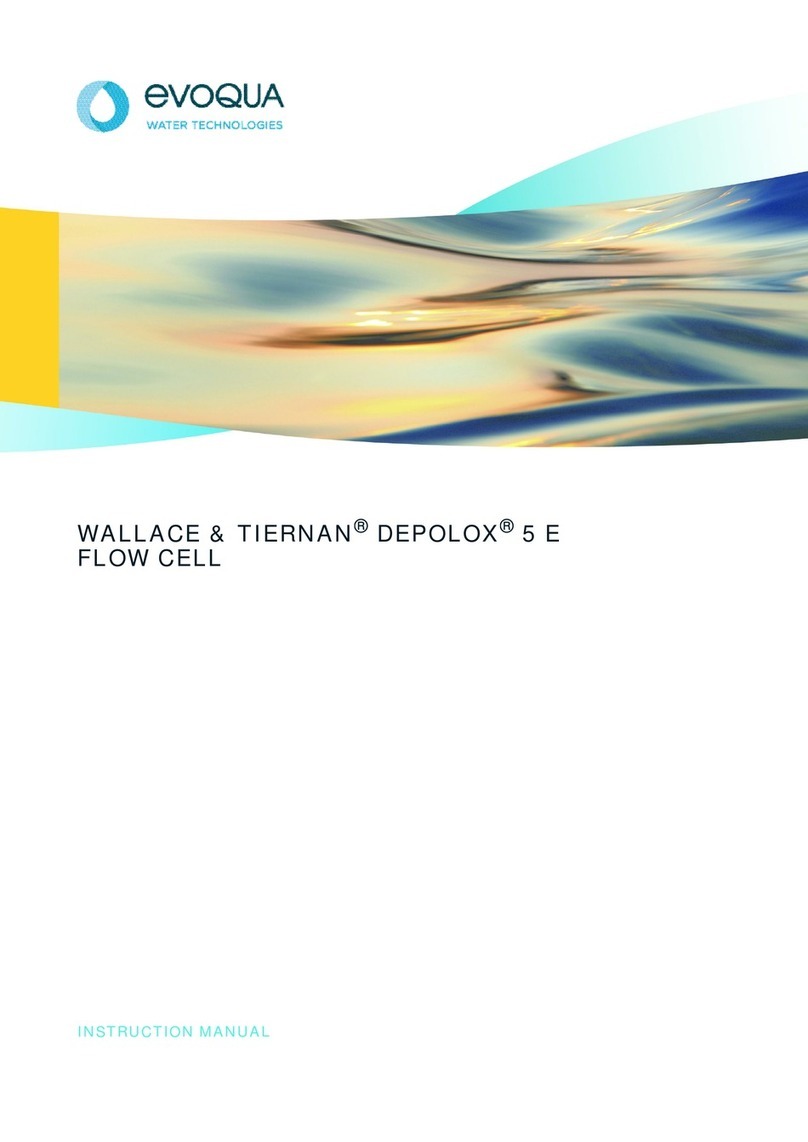
Evoqua
Evoqua WALLACE & TIERNAN DEPOLOX 5 E User manual
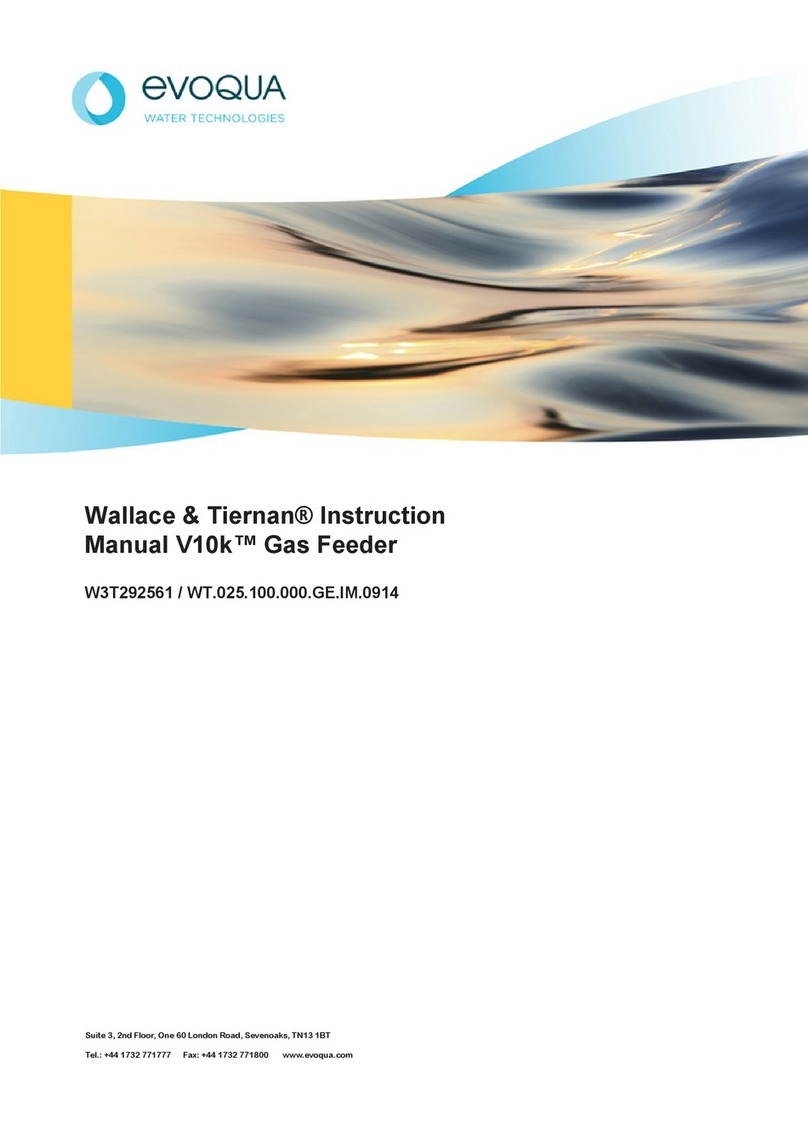
Evoqua
Evoqua V10K User manual

Evoqua
Evoqua Wallace & Tiernan SFC-SC User manual
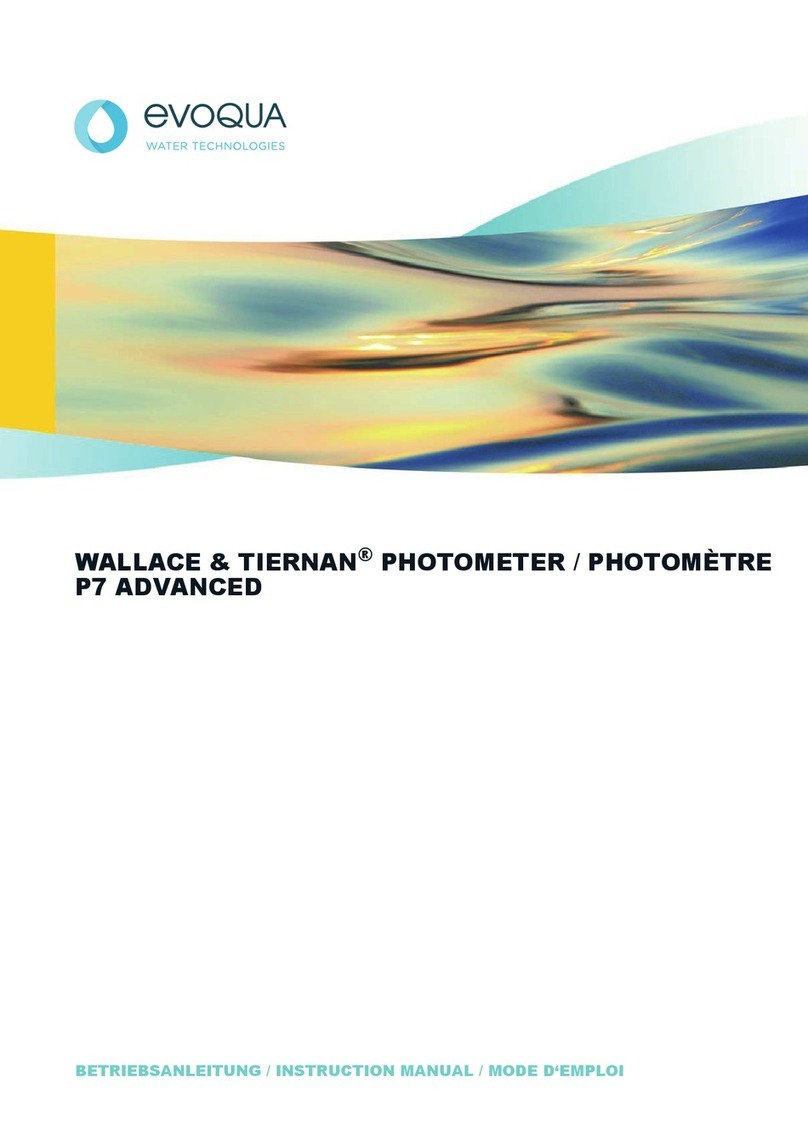
Evoqua
Evoqua WALLACE & TIERNAN P7 ADVANCED User manual

Evoqua
Evoqua WALLACE & TIERNAN SFC BA W3T166501 User manual

Evoqua
Evoqua Wallace & Tiernan Depolox 3 plus User manual

Evoqua
Evoqua DEPOLOX User manual
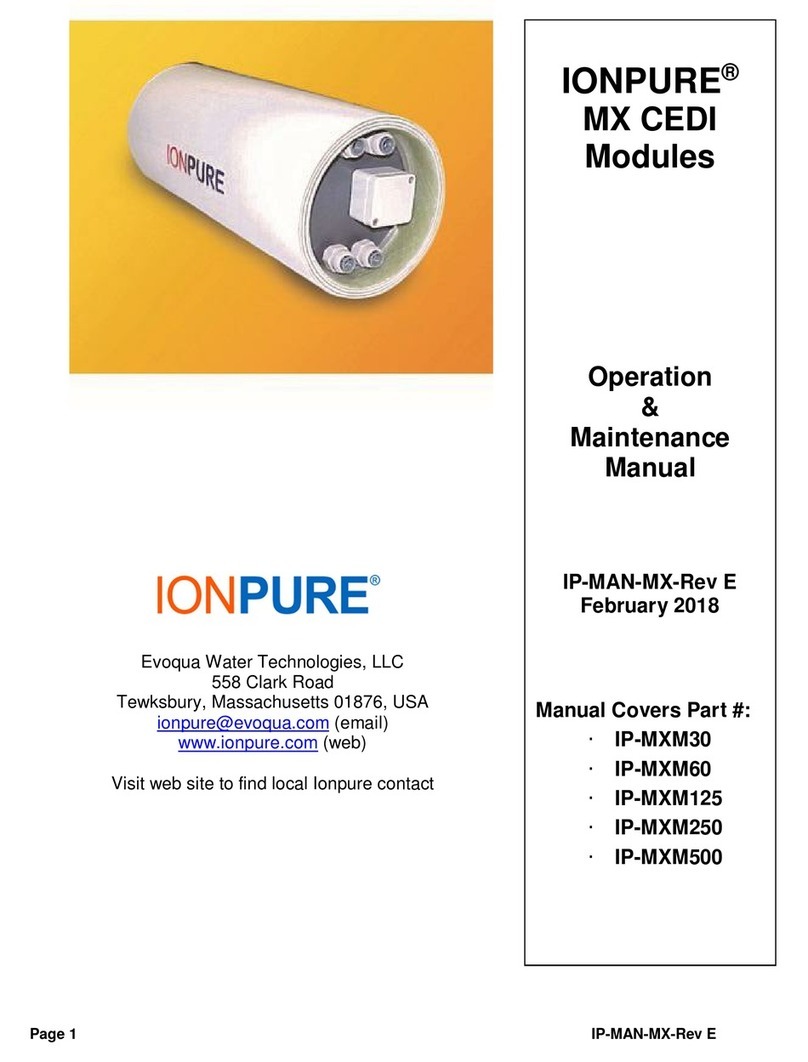
Evoqua
Evoqua IONPURE IP-MXM30 Manual
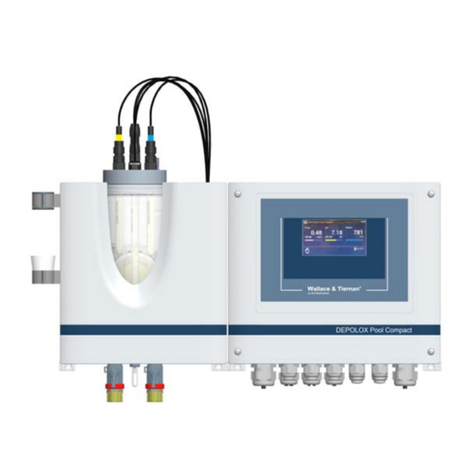
Evoqua
Evoqua DEPOLOX POOL COMPACT WALLACE & TIERNAN User manual


